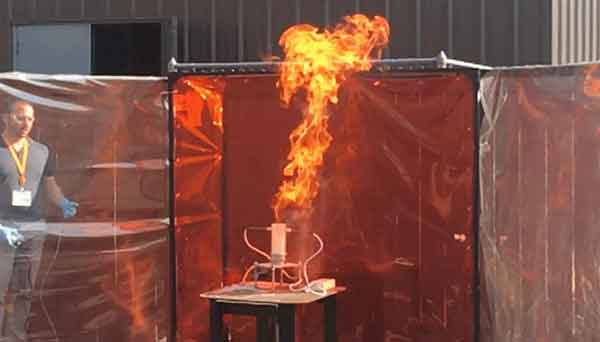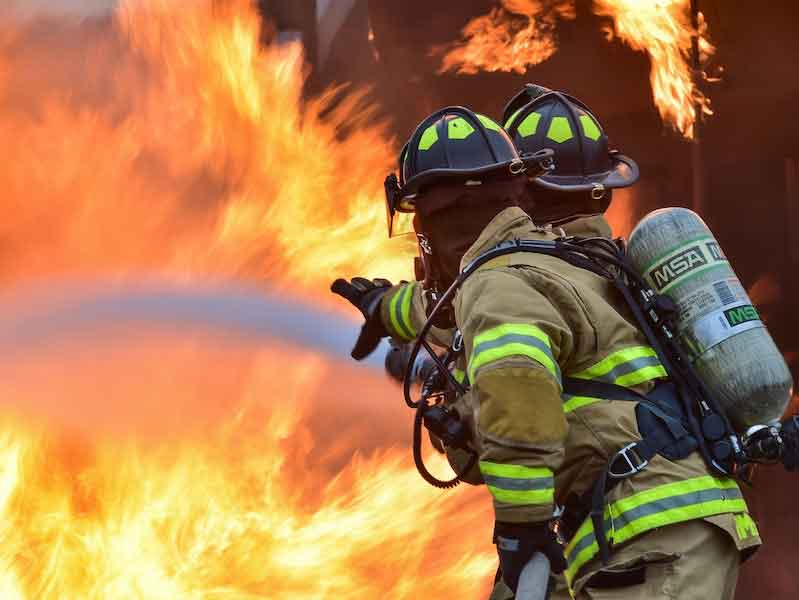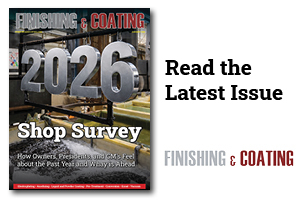Powder coating has been a favored painting method by manufacturers for many years due to low costs, high durability, high efficiency, and limited wasted product.
 Ron Allen and Casey AllenYet, in spite of the widespread utilization of the method and the expectation for continued growth in the powder paint market — the North American market expected to grow by 6.8% annually through 2025 — many operators are only loosely aware of the combustibility hazards posed in the handling and application of powder paints.
Ron Allen and Casey AllenYet, in spite of the widespread utilization of the method and the expectation for continued growth in the powder paint market — the North American market expected to grow by 6.8% annually through 2025 — many operators are only loosely aware of the combustibility hazards posed in the handling and application of powder paints.
This article summarizes common hazards associated with the powder paint process, operational safeguards which can be implemented to mitigate risk, and common pitfalls that may lead manufacturers to unknowingly enhance the risk of a combustible dust deflagration or fire in their facility.
The Hazards of Powder Coating
 Powder paints are small diameter powders with low minimum ignition energies (MIEs) -- generally in the range of 3 to 20 mJ (Eckhoff et al., 1988). At these levels, powder paints are susceptible to ignition through static discharges that occur during pouring of material or even through personnel that becomes charged during normal work operations. Once ignited, airborne dust clouds can do substantial damage, especially when the deflagration propagates to adjacent areas or pieces of equipment.
Powder paints are small diameter powders with low minimum ignition energies (MIEs) -- generally in the range of 3 to 20 mJ (Eckhoff et al., 1988). At these levels, powder paints are susceptible to ignition through static discharges that occur during pouring of material or even through personnel that becomes charged during normal work operations. Once ignited, airborne dust clouds can do substantial damage, especially when the deflagration propagates to adjacent areas or pieces of equipment.
To safeguard against igniting a powder paint cloud in the booth, airborne concentrations should be maintained well below the minimum explosible concentration (MEC) of the material. NFPA 33 advises not exceeding 50% of the MEC to provide a margin of safety, although manufacturers should be advised that even at these bulk concentrations, local regions within the booth may approach or exceed the MEC. For an accurate understanding of the hazards, it’s best to test the MEC and other explosibility characteristics of the powder paints being used. Explosibility data is occasionally available from the paint manufacturer; however, it may not be representative of the actual hazards where fine particles accumulate, such as in central vacuum systems or dust collectors.
The practice of controlling airborne concentrations to provide the “50% of MEC” safety margin can be very challenging because operators’ primary focus is to ensure good part coverage, and no real-time feedback is available regarding paint concentrations in the booth. When coupled with a lack of understanding of the hazard, this focus on product quality can easily lead to hazardous airborne dust concentrations. Powder paint operators can be especially vulnerable to this hazard because they often work in booths, and they may not be protected by flame-resistant clothing.
Where to Find the Rules
Standards published by the National Fire Protection Association (NFPA) provide the requirements for identifying and managing combustible dust, fire, and explosion hazards. Manufacturers that use powder painting operations should consult the requirements published in the following standards:
- NFPA 652: Standard on the Fundamentals of Combustible Dust
- NFPA 654: Standard for the Prevention of Fire and Dust Explosions from the Manufacturing, Processing, and Handling of Combustible Particulate Solids
- NFPA 33: Standard for Spray Application Using Flammable or Combustible Materials
These standards prescribe acceptable practices for managing the risk of a combustible dust incident and additionally define the requirement for completing a Dust Hazards Analysis (DHA). Per NFPA 652: “[The DHA] is a systematic review [by a qualified person] to identify and evaluate the potential fire, flash fire, or explosion hazards associated with the presence of one or more combustible particulate solids in a process facility.” The NFPA established a September 7, 2020, deadline for completing the DHA; thus, facilities that have not completed a DHA are not compliant with NFPA requirements.
Bonding and Grounding Considerations
The prevention of credible ignition sources in the paint booth is an important safeguard against a combustible dust incident. One of the most common ignition sources for powder paint is electrostatic sparks. To this end, effective bonding and grounding practices are critical, especially because of the low MIE of powder paints.
These practices are not only important from an “ignition-proofing” perspective but also from a quality control perspective. Parts that are being powder coated are generally grounded through a conveyor system to provide better coverage and adhesion from positively-charged powder paint. However, the bonding and grounding requirements to reduce ignition risks are more stringent than the requirements for promoting effective paint adhesion. This disparity may lead to paint booth operators growing insensitive to the hazards if the acceptable part quality is provided without a history of loss at a facility.
Effective grounding is defined by NFPA as resistance to ground of less than 1 megohm. This requirement applies to all conductive parts and surfaces of a paint booth, including the floor, operator platforms, powder hoppers, and even personnel. Furthermore, the resistance between adjacent conductive components is limited to 10 ohms.
Ensuring the grounding of personnel is critical, given the low MIE of powder paints, and preferred methods include dedicated grounding straps worn by operators or grounding through the spray gun provided by skin-to-gun contact. Operators may be tempted to wear gloves to protect themselves from paint exposure, but this can lead to a loss of electrical ground and unsafe conditions unless the gloves are conductive and approved for use.
A less effective approach for grounding personnel includes the use of electrostatic dissipative (ESD) footwear. The use of ESD footwear is discouraged in the paint booth because even though the floor is required to meet the NFPA grounding requirement of a sub-1-megohm resistance to ground, powder paint accumulates on the floor continuously during spraying and may render the ESD footwear ineffective.
One other important grounding consideration is maintaining an effective bond between parts being painted and the paint conveyor. Conveyors commonly use a custom jig and hook sets for hanging parts of different geometries on the conveyor. Just as with the part being painted, the hooks accumulate powder paint which is hardened on the hooks while passing through the curing oven. The hooks must be frequently cleaned to ensure that paint accumulation doesn’t interfere with the grounding of the parts. While “bake-off” ovens are generally effective for this cleaning, their effectiveness should be frequently inspected to reduce the risk of a hazardous condition in the booths.
Tips for Reducing the Hazards of Powder Coating
Given the considerations listed in this article, the following safeguards should be considered by manufacturers:
- Train Personnel on the Hazards of Powder Paints: A good combustible dust management program includes robust training for personnel that is exposed to the hazards of combustible dust. The training program must ensure that personnel operating in and around the paint booth understand the risks of igniting combustible dust and the contrast between grounding for product quality versus grounding for the removal of ignition sources. Personnel that maintains the booths, central vacuum equipment, and dust collectors should also be trained.
- Test Your Dust and Make a Plan: The explosibility of powder paints varies by particle size and resin type. Additionally, changes in the powder particle size distribution during paint application and collection may render manufacturer explosibility data invalid. Paint booth operators should take steps to obtain explosibility data for powders sampled from their processes to ensure the validity of the data. The most important metrics to understand include ignition sensitivity measures (MIE, MEC) and explosion severity measures (KSt, Pmax). In the absence of test data, NFPA 33 does allow manufacturers to assume a MEC value of 30 g/m3. Once these data points are in hand, paint booth operators should implement controls to avoid creating hazardous conditions.
- Verify Effective Bonding and Grounding: The susceptibility of powder paints to ignition makes it essential that effective bonding and grounding are in place at all times. The resistance to ground for conductive components of a paint booth should be routinely measured to ensure compliance with NFPA. Policies that ensure personnel is grounded are also important and must be enforced at all times. Due to its importance in the grounding of parts being painted, manufacturers may also consider the installation of a ground monitoring system for the conveyor.
- Develop and Enforce a Housekeeping Program: Good housekeeping goes a long way toward reducing the risk of a combustible dust incident because it removes the powder fuel source needed for deflagration. Paint booth operators should define a schedule of cleaning that prevents hazardous accumulations from developing in and around the booth. This requires discipline and a special caution toward the risks because hazardous accumulations may develop quickly, and operators may be tempted to overlook accumulations due to fatigue. The housekeeping scope should include sprinkler and fire detection systems which may not operate as designed when covered by excessive powder. Cleaning methods should comply with NFPA requirements.
Summary
This article summarizes some of the elements that powder paint booth operators must consider in order to reduce the hazards of experiencing a dust flash fire or deflagration. Adherence to the NFPA standards will substantially reduce the risk, and partnering with the FAI ISO 17025 laboratory and combustible dust experts can ensure that the NFPA requirements are properly applied.
Casey M. Allen, Ph.D., is an Associate Professor at Marquette University and can be reach d at casey.allen@marquette.edu. Ronald L. Allen, MS, PE, CSP, is a Senior Consulting Engineer at Fauske & Associates and can be reached at allen@fauske.com. FAI collaborates with their customers to ensure the safety and reliability of their chemical processes, industrial facilities, and power plants while maintaining regulatory compliance, extending plant life, and reducing operation and maintenance costs. Contact them at dha@fauske.com
Fauske & Associates (FAI) led to innovative methodologies and tools to characterize reactive chemical hazards, design emergency relief systems, and simulate severe accidents in commercial nuclear power plants. FAI is recognized worldwide for phenomenological modeling, testing, and consulting services to mitigate or prevent accidents at chemical and nuclear facilities. FAI offers a wide range of services related to Dust Hazards Analysis (DHA) characterizing, dust explosion testing, preventing and mitigating combustible dust explosion, dust combustion and fire hazards. These services include combustible dust testing, onsite assessments, OSHA and NFPA compliance assistance, audit preparation, training, ignition source evaluation and vent sizing calculations.

































